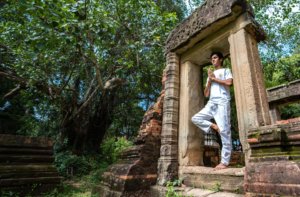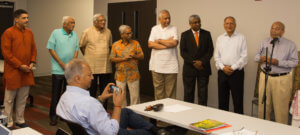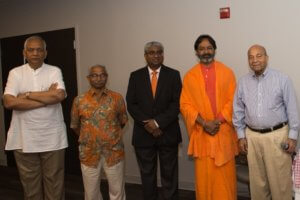
There is nothing in existence that is unfeeling, nothing that is profane or unspiritual, nothing without a unique value in the cosmos. Life is relational, interdependent, interconnected, a system of mutual nourishment and care, not only physically, but also psychologically and spiritually.
Dr. David Frawley
Just from the very beginning when a new baby is born, a new flower is born or any new manifestation of life is born, there is a spontaneous synchronization that naturally arises in the environment. That new form of life is completely exposed to grow within whatever environment happens to be around, and that atmosphere becomes the natural space from where all skills and faculties start developing. My effort to understand the purpose of creation and the power of evolution has brought me the realization that great attention is needed nowadays towards transforming and reestablishing the structure of our society and our way of living. Modern life´s purpose is encapsulated in a disoriented endeavor to always become ´someone´ as if we weren´t already what we were supposed to be in life. Sadly, this atmosphere that our society has built for us as the ¨natural space¨ creates and accumulates many fears within ourselves.
Traditional Indian Yoga has been preserving its sacred and spiritual heritage since thousands of years ago, when India´s ancestors contemplated evolution, development, and growth of human life as a balanced and integrated circle from birth to death, and then onto rebirth again. The journey of this progressive transformation in a single lifetime was framed in terms of four phases of life, that could potentially represent guidance for all communities today. These four phases were described by Swami Niranjanananda as Brahmacharya where “One equips oneself with knowledge and wisdom of the world to survive in the word”; “Grihastha”, where, with the knowledge acquired, one works to support one´s family, society, nation, and world; “Vanaprastha”, where one spends time in reflection, contemplation, and the discovery one´s self; and “Sannyasa”, where one reaches out to help and uplift those in need so they can overcome their physical, mental, spiritual, social and psychological limitations. By adopting these principles of life all living beings can surely begin to live in harmony and communion!
These four important stages in life were explained by the Vedas i.e. ancient Hindu texts. They said that for the beginning of life´s circle, humans should be focus on developing the Brahmacharya and Grihastha stages – Learning or acquiring knowledge and taking on social responsibilities is the central force in these two phases because naturally, our energy moves towards these responsibilities and accomplishments. Now, the process of absorbing information from the outside world, becomes a confusing stimulus to our sense organs, as the atmosphere around the world is today quite obsessed in finding more and more products and experiences that target our sensory satisfaction, to such an extreme extent that everything is being created with a business purpose that supplies newly created market needs. In fact, the market place keeps inventing new needs for us, that we never knew we had to begin with.
Vanaprastha, the following third chapter of life is a crucial and beautiful moment, where, as a revolutionary decision against our social conditioning and acquired beliefs, one starts feeling the need to discover what is behind all the purposes and activities of the preceding years of active engagement and sensory satisfaction. It is a moment when one begins to walk towards the truth, learn the art of observation newly, and embarks on re-education of the mind, in such a way that the influence of the material world reduces, and the spiritual world expands. The mind enters into a process of progressive detachment from all conclusions and concepts, previously held to be true and inviolable.
Surprisingly, our perspective towards our family, society, and career naturally starts turning into an explorative path that aligns increasingly towards an intention to become a better and more selfless person. There arises a whole spontaneous synchronization of our individual consciousness with the supreme consciousness that favors increasing attention and observation of the whole movement of life.
In the four-stage of life Sannyasa, one pool together all one´s resources, strength, creativity, and potential into a trust so the purpose of contribution and upliftment of others becomes the main priority in our lives, even as our self- observation continues. With the continued input of positive inspiration into our minds, this is an ongoing process of protecting our thoughts and negative influences of the environment.
I believe that despite the pressures and distractions of our modern world, there is still potential to embrace the richness of these four stages of life. The integration of yoga in our lives is an opportunity for a profound transformation in our being. But in order to change the materialistic patterns of our mind, we might subject ourselves to exploratory and systematic guidance in the traditional Ashtanga Yoga of Patanjali.
Although yoga has become increasingly popular and being adopted worldwide, there are some visible and fundamental misunderstandings about the nature of yoga – the modern version is still too heavily focused on its material and physical benefits. The real purpose of practicing yoga represents a profound journey towards self-observation, reflection, contemplation, study, and development of personal creativity, as an integrated movement towards supreme consciousness, the oneness that equals real and total freedom.
In conclusion, traditional yoga is a lifestyle that gives us an explorative experience, where slowly we can initiate a transformation in our attitudes, awareness, consciousness, perception, and aspiration. This potential of the mind-expanding towards the universal consciousness and well-being arises through the transformation of the nature, behavior, and actions of the mind. From a wider perspective, any process of life that helps to transcend our limitations and transforms our consciousness is yoga; so everything – the way we breathe, sit, stand, eat, walk and work – can be integrated into yoga.










